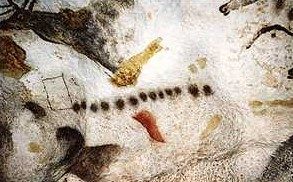Mathematics stretches well into prehistoric history and knowledge of its origins and initial applications is mostly built on speculation. Because of this, it’s reasonable to assume that our prehistoric ancestors would have had a general understanding of amounts, and would have instinctively known the difference between the quantity of one thing and the quantity of two things. Basic counting like this would have likely been facilitated by the use of our hands, with each finger representing a numeral.
This would have worked well for small quantities, but how did our prehistoric ancestors count quantities bigger than ten? Evidence shows that they began using notches or marks to represent numerals. In doing so, they not only created one of the first mathematical records, but they also created the first known method of tracking larger numbers.
The Ishango Bone, discovered around 1960 on the border of Zaire and Uganda by the Belgian geologist Jean de Heinzelin, is considered by many to be the earliest mathematic artefact ever recovered. The origins of this artefact date to approximately 20,000 B.C.E. and consists of a series of tally marks carved in three rows running the length of the bone.
The bone itself has been subject to a lot of interpretation. At first, it was thought to be just a tally stick with a series of tally marks, but scientists have demonstrated that the groupings of tallies on the bone are indicative of a mathematical understanding which goes beyond simple counting. In fact, many believe that the tallies follow a mathematical succession, with some going as far as to say it shows the earliest known demonstration of the prime number sequence.

The first row (a) can be divided into 4 groups, where each group has 9, 19, 21, and 11 tallies. The sum of these 4 numbers is 60. The second row (b) can be divided in 4 groups, with each group possessing 19, 17, 13, and 11 tallies. These are the 4 successive prime numbers between 10 and 20. This constitutes a quad of prime numbers. The sum of these is 60. The third row (c) can be divided into groups of 8 and features two sets of numbers (3 & 6 and 4 & 8) that may represent multiplication by 2, and one set of numbers (10 & 5) that relates to division by 2. Lastly, the first row (a) and second row (b) both add to 60, while the third row adds to 48. Both 48 and 60 are divisible by 12.
These mathematical trends suggest some basic understanding in terms of grouping numbers, but some people think they are not significant enough. The argument is strengthened by the absence of any other archaeological discoveries that indicate an understanding of the prime number sequence dating from that time period. However, despite the considerable debate surrounding the actual implications of the Ishango Bone and the fact we’ll never really know what these tallies represent, I’d like to believe that the tally marks are evidence of the first primitive counting tool.
The notion of humans understanding mathematics can also be illustrated in the Lascaux cave paintings in France.

Some of the markings indicate a basic human understanding of the 29-day lunar cycle. In one case, there are 14 dots followed by an empty square, which experts believe represent the 14 days that the moon is visible in the night sky and the day that it disappears. This suggests that part of our early mathematical understanding of counting derived in part from observational astronomy.
And so, whether it be counting or making sense of objects in the sky, it’s clear that early mathematics developed as a result of our ancestors’ need to understand and make sense of the world around them. And although the mathematics used today is vastly different, the same necessity still stands.
Drawing on history in this way can show children the need for mathematics and links in well with the four principles of PUFM. Being able to see the connections between the tally marks and their potential purpose helps us to understand and make sense of how our basic foundation for counting and recording has developed. Also realising that there’s no one right answer in terms of knowing what these tally marks or cave paintings mean highlights the need for multiple perspectives in terms of fostering a more flexible way of thinking.
References
‘A History of Mathematics’ available at: http://www.storyofmathematics.com/




